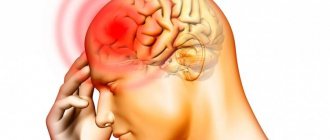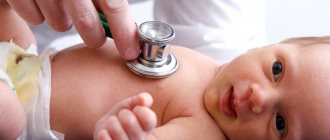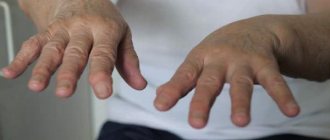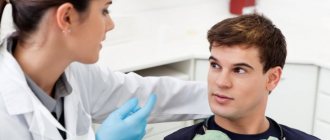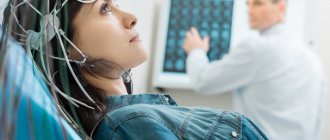Epileptic seizure. Description. First aid
Development of an epileptic seizure
The most striking sign of epilepsy is an epileptic seizure, the frequency of which depends on the severity of the disease. In the development of such a state, several stages can be distinguished - aura, tonic and clonic stages, as well as a phase of complete stupefaction. Many patients with the onset of a seizure experience warning signs such as headaches, irritability, palpitations, malaise and insomnia. In this regard, a person can learn a few hours before that an epileptic attack is approaching.
First aid
The resulting epileptic seizure in most cases lasts only a couple of minutes. During this period of time, the complete safety of the victim should be ensured and everything possible should be done to alleviate his suffering. Tonic-clonic generalized seizures tend to frighten those around them, so it is important not to panic, since first aid for an epileptic seizure should be as fast and effective as possible. In order to cope with this task, you should adhere to some rules:
- remain completely calm;
- free the victim from constricting clothing and make sure that he is able to breathe freely;
- remove hot, piercing and cutting objects away so that the patient does not get hurt;
- turn the person on his side so that he does not choke on saliva, place a small cushion under his head and let him rest for a while.
After the attack ends, the victim may feel dazed, weak and confused, so you should not leave him alone, as he may need outside help. If an epileptic seizure occurs in a child, it is necessary, if possible, to contact his parents or other relatives. If you are sure that the victim has been suffering from epilepsy for a long time, you do not need to call an ambulance, since the duration of the attack, as a rule, does not exceed five minutes.
Reasons for urgently calling an ambulance:
— primary development of an epileptic attack;
- long duration of the attack and its replacement by other attacks, during which the person does not regain consciousness;
- the occurrence of epileptic seizures in a pregnant woman;
— the victim has diabetes mellitus;
- serious injury to the patient during an attack.
What is status epilepticus?
This is the most dangerous and severe complication of epilepsy. Status epilepticus is a human condition when an epileptic seizure is replaced by more and more new attacks, the total duration of which reaches 30 minutes or more. All this time the patient is unconscious, which can lead to serious complications, including death. It should be noted that this condition can occur as a result of abrupt withdrawal of antiepileptic drugs or a significant reduction in their dosage. The consequences of status epilepticus can be: acute swelling of the brain, cardiovascular failure and pulmonary edema, which requires immediate hospitalization of the patient and putting him into narcotic sleep.
Clinical picture
The most severe clinical picture was observed in patients with epidemic meningitis with convulsive syndrome. The disease is characterized by a rapid onset and rapidly progressive deterioration.
Against the background of high fever, hemorrhagic rashes on the skin, a drop in blood pressure, increasing respiratory failure, severe cerebral symptoms (severe headache, vomiting), meningeal signs (stiff neck, Kernig's sign), early development of a coma with suppression of reflex activity, muscle hypotension, generalized tonic-clonic (less commonly clonic) seizures develop, lasting from 2 to 5 minutes with a frequency of 2 to 10 seizures per hour.
Examples of illness
Heart sounds are very muffled. The pulse cannot be felt. Blood pressure is not determined. Neurological status: severe neck rigidity, Kernig's sign, lower and upper Brudzinski's symptoms. Floating movements of the eyeballs. Exotropia. The pupils are narrow, their reaction to light is absent.
Corneal reflexes are not evoked. Muscle atony. Tendon and periosteal reflexes are absent. Generalized clonic convulsions occur at intervals of 10-12 minutes, lasting up to 4 minutes. Diagnosis: meningitis, meningococcemia. Status epilepticus. The patient was sent to the infectious diseases hospital, where the diagnosis was confirmed.
Thus, a feature of this observation was the development of generalized status epilepticus of clonic seizures on the first day of epidemic meningitis.
We also observed a rare case in which epileptic seizures turning into status were the onset of tuberculous meningitis.
Patient M., 55 years old. Previously he was healthy. During the day at work, at the machine, a convulsive attack suddenly developed. The emergency medical team recorded repeated seizures, starting with turning the head and moving the eyeballs to the right, followed by convulsions in the right half of the face and in the right limbs.
After a few seconds, the convulsions become generalized and are tonic in nature. The patient was taken to the hospital, where the seizures recurred. Pulse 90 per minute, rhythmic, blood pressure 140/70 mm Hg. Art. At the end of the seizure, the left pupil is slightly wider than the right, muscle hypotonia, predominant in the right extremities, mild rigidity of the muscles of the back of the head. In the hospital, during intensive therapy, seizures recurred several times during the day.
Body temperature 38°C. There was a slight smoothing of the left nasolabial fold, a slight increase in spastic type muscle tone on the right, and a predominance of deep reflexes on the right. Mild meningeal syndrome. Bradycardia was detected, pulse 64 per minute. Cerebrospinal fluid is colorless and transparent. Composition: protein 6.6 mg/l (0.66
Thus, in this observation, status epilepticus was the debut of the clinical manifestation of tuberculous meningitis. Characterized by the rapid onset of organic neurological symptoms, bradycardia, and the absence of changes in the blood characteristic of status epilepticus (leukocytosis, shift to the left).
Muscle cramps - how to treat?
For complaints of seizures, treatment is carried out by restoring the water-salt balance, massage, and maintaining a healthy lifestyle. It helps to introduce foods rich in potassium, magnesium, and calcium into the diet: cottage cheese, cheeses, bananas, sauerkraut, legumes.
Self-massage, pinching the shin, pulling the foot or big toe towards you helps with painful spasms. In cases of severe spasms, physiotherapy and acupuncture are also prescribed. If you experience prolonged, painful, unusual sensations of muscle cramps after training, you should consult a doctor.
If you are aware of the presence of a disease that manifests itself as seizures, then avoiding seizures during movement can only be done by treating the underlying cause of the seizures.
True seizures are caused by excitation of neurons in the cortex or subcortical structures of the brain. Therefore, any convulsive phenomenon should cause close attention to the person’s health and a visit to the doctor.
Epilepsy, unspecified - example of writing a call card
Male, 36 years old. The reason for the call is that he is unconscious on the street, the reason has not been established (passers-by call).
Complaints, medical history
At the time of inspection, he makes no complaints about what happened and doesn’t remember. He is located on the street near the store, sitting on the porch.
According to others, about 10-15 minutes ago there was an attack of tonic-clonic seizures with loss of consciousness and foam at the mouth. No treatment was undertaken. This is not the first time this has happened; I previously went to the emergency room for epileptic seizures.
Anamnesis of life
Epilepsy, the patient is registered as an outpatient with a neurologist. Regularly takes anticonvulsant medications. Comfortable blood pressure cannot be explained.
Physical examination
- moderate condition;
- level of consciousness - stunned (13 according to Glasgow school), behavior is inhibited;
- pupils are normal, D=S, reaction to light is lively, gaze paresis is absent, horizontal nystagmus;
- the skin is dry, clean, physiologically colored, the mucous membranes are not inflamed;
- heart sounds are clear, rhythmic, there are no noises, the pulse in the peripheral arteries is rhythmic, of satisfactory quality;
- from the central nervous system – there are no meningeal symptoms, muscle tone is increased, there are no focal symptoms;
- the pharynx is calm, the tonsils are of normal size;
- chest excursion is normal, breathing is normal, percussion – pulmonary sound, auscultation – vesicular breathing, no wheezing;
- no peripheral edema;
- the tongue is moist, clean;
- the abdomen is soft, painless, regular in shape, takes part in the act of breathing, there are no symptoms of peritoneal irritation;
- the liver does not extend beyond the edge of the costal arch;
- chair – 1 time per day, decorated;
- diuresis is normal, SSPO is negative.
Main pathology
The patient is stunned, inhibited, inadequate, lost orientation in time and space. There are marks of teeth on the tongue, and there are also signs of involuntary urination. Consciousness gradually recovered during the examination. No signs of head injuries were found.
| time | 17-30 | 17-50 | 18-10 | Etc. peace |
| NPV | 16 | 16 | 16 | 16 |
| Pulse | 86 | 84 | 76 | 72 |
| Heart rate | 86 | 84 | 76 | 72 |
| HELL | 150/90 | 130/80 | 130/80 | 130/80 |
| Pace. ºС | 36,6 | |||
| SpO2 | 97 | 97 | 97 | 97 |
Blood glucose – 6.9 mmol/l;
ECG data: sinus rhythm, 83 beats/min, no signs of acute pathology of the heart and blood vessels. There is no ECG archive.
Diagnosis by the EMS team
Epilepsy of unknown origin, condition after an attack.
Therapeutic measures
17-39 – Sol. MgSO4 25% – 10 ml i.v.
The patient was hospitalized in the neurological department of the city hospital.
Common types of seizures
Some convulsive manifestations occur quite often and are in the nature of a symptom of a temporary painful condition. In other cases, seizures can accompany a person throughout his life. Depending on the cause of the seizures, the type of seizure, the age and status of the person, specialists choose the type of therapy. However, when there are complaints of seizures, treatment and therapy are always aimed not at the symptom, but at the underlying disease.
Febrile seizures
Two and a half millennia ago, in his treatise “On the Sacred Disease,” Hippocrates described febrile convulsions as a symptom most often found in children under 7 years of age. Modern research confirms that convulsions due to hyperthermia develop mainly in children aged six months to five years. Febrile seizures in adults are quite rare and are caused not only by an increase in body temperature.
Precursors of seizures
Aura (from the Greek - “blow”) is a harbinger of an epileptic attack and precedes loss of consciousness, but not in any form of the disease.
The aura can manifest itself with various symptoms - the patient may begin to sharply and frequently contract the muscles of the limbs and face, he may begin to repeat the same gestures and movements - running, flapping his arms. Various paresthesias can also act as an aura. The patient may feel numbness in various parts of the body, a crawling sensation on the skin, and some areas of the skin may burn. There are also auditory, visual, gustatory or olfactory paresthesias. Mental precursors can manifest themselves in the form of hallucinations, delusions, which are sometimes called preconvulsive insanity, a sharp change in mood towards anger, depression, or, conversely, bliss.
In a particular patient, the aura is always constant, that is, it manifests itself in the same way. This is a short-term state, lasting a few seconds (rarely more), while the patient is always conscious. An aura occurs when an epileptogenic focus in the brain is irritated. It is the aura that can indicate the dislocation of the disease process in the symptomatic type of epilepsy and the epileptic focus in the genuine type of the disease.
Nonconvulsive manifestations
About half of epileptic seizures begin with non-convulsive symptoms. After them, all kinds of motor disorders, generalized or local convulsions, and disorders of consciousness can be added.
Among the main non-convulsive manifestations of epilepsy are:
- all kinds of vegetative-visceral phenomena, irregular heart rhythm, belching, occasional increase in body temperature, nausea;
- nightmares with sleep disorders, talking in sleep, screaming, enuresis, somnambulism;
- increased sensitivity, worsening mood, fatigue and weakness, vulnerability and irritability;
- sudden awakenings with fear, sweating and palpitations;
- decreased ability to concentrate, decreased performance;
- hallucinations, delirium, loss of consciousness, pale skin, feeling of deja vu;
- motor and speech retardation (sometimes only in sleep), attacks of numbness, disturbance in the movement of the eyeball;
- dizziness, headaches, memory loss, amnesia, lethargy, tinnitus.

